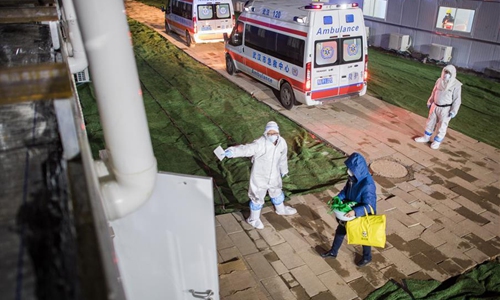HOME >> SOURCE
Reflections on China’s healthcare infrastructure amid epidemic
Source:Global Times Published: 2020/2/10 21:59:44

Patients enter the ward of Leishenshan Hospital in Wuhan, Central China's Hubei Province on Saturday. Photo: Xinhua
China still has a long way to go in terms of the construction of its medical system, as is reflected in the outbreak of novel coronavirus pneumonia (NCP), despite the fact that its per capita GDP has just crossed the $10,000 mark.While the central government has mobilized medical resources nationwide to aid Wuhan - the epicenter of the epidemic in Central China's Hubei Province - and two special hospitals have been tasked with treating NCP patients, the city's medical system may still face great pressure due to the shortage of medical resources. The 1,000-bed Huoshenshan Hospital and the 1,600-bed Leishenshan Hospital were built in less than two weeks.
While the speed of China's infrastructure construction is impressive, there is no quick fix for its medical woes which are felt acutely amid the current epidemic. China's healthcare system has long been under enormous pressure, and Wuhan's situation may be just one manifestation of that pressure.
How to strengthen the construction of China's medical system is a problem we need to reflect on while seeking economic growth. Although China has been reforming its healthcare system over the years, the results have thus far not been encouraging, with discontent from both patients and doctors.
Without the input of sufficient medical resources, including medical staff, equipment and infrastructure, China's medical system cannot be reformed.
The growth of medical resources has always lagged behind the growth of medical demand in China. During the 10 years from 2008-17, the number of hospital visits in China doubled from 1.78 billion to 3.44 billion. However, the number of physicians only grew from 1.58 per 1,000 people to 2.44 during the same period, an increase of just 54 percent.
Fundamentally speaking, the shortage of healthcare resources has led to the shortage of medical services, and the only way to solve the current issues is to improve the imbalance between supply and demand.
In this sense, China should strengthen its health infrastructure in the near future, particularly in rural and remote areas. The NCP outbreak has already shown that medical facilities in some areas are outdated and cannot meet the medical needs of local people.
Thus, the number of hospitals in China should grow as quickly as other infrastructure projects like highways. It is hoped that after the epidemic, various local governments will speed up their investments in increasing medical services, including the construction of hospitals and purchases of medical equipment that is urgently needed in rural hospitals and clinics.
Posted in: GT VOICE